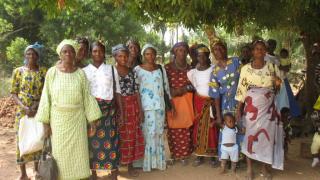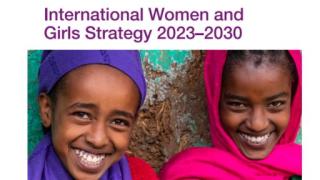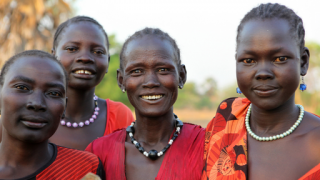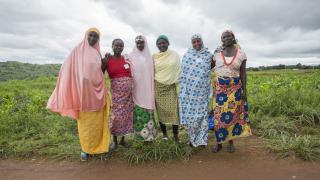The UK Government’s new Women and Girls Strategy: Should we be celebrating?

The UK Government recently published two long-awaited policies: its 5th National Action Plan (NAP) on Women, Peace and Security (WPS) and its International Women and Girls Strategy. Both made some welcome commitments, reflecting how collective and sustained advocacy - anchored in women’s experiences - can indeed contribute to small wins in a broader context of a global rollback on women’s rights, no matter how painstaking those advocacy efforts or granular those wins may feel. So, what are those small wins and are they worth celebrating?
For a long time, we have been advocating for women and women’s rights organisations living and working in conflict and crisis contexts to be recognised as partners by the UK Government. We know that their expertise and leadership is fundamental for tackling gender inequality. So, it was promising to see that, across both the NAP and the International Women and Girls Strategy, women’s rights organisations (WROs) and feminist movements have been recognised as strategic partners. This recognition offers a pathway for both collaboration and accountability, where civil society’s expertise can be effectively leveraged by government and where the government’s progress against its commitments can be monitored and openly discussed.
However, for this potential progress to truly be considered a ‘win’, these partnerships must be meaningful. That means they can’t be based on isolated interactions and there must be clear benefits for those involved, including learning exchanges, access to resources and funding. We welcome the acknowledgment of this in both the NAP and the International Women and Girls Strategy. In the NAP, the Beyond Consultations tool - a guide we built with our partners on how to meaningfully engage and consult with women in fragile and conflict affected states - is referenced as a practical tool to support the UK Government achieve their commitments to WROs. And, in the International Women and Girls Strategy, a new emphasis is made to “embolden and amplify the work of diverse grassroots women’s organisations and movements”, including through a commitment to provide £38 million of funding to WROs.
If this direct funding to WROs also removes rigid funding barriers and increases flexibility of funding scope, then meaningful long-term partnerships will become more attainable and more effective at advancing the Women, Peace and Security Agenda and achieving gender equality (we have the evidence!). These certainly look like wins and talk like wins, but we aren’t ready to celebrate them as victories just yet.
Celebrations can begin when we see tangible results. For now, we are left with more questions than answers…
1. How will these strategies be funded?
With the launch of this strategy, the UK Government announced £238 million (including the £38 million mentioned above) in funding for work with women and girls, and committed that at least 80% of UK-funded programmes will have a focus on gender equality by 2030. This is welcome but is a drop in the ocean in the context of the £1.9 billion in funding to gender equality programmes that the UK Government is estimated to have cut between 2019 and 2021. We felt the impact of these cuts first-hand with our programme in Bauchi, Nigeria, and so we know from experience that gender-transformative change will be limited unless the government puts its money where its mouth is.
2. How will these strategies work together?
Over the past two years, the UK Government has published a handful of policies and strategies that have implications for how it will meet its commitments to uphold and protect women’s rights: the International Development Strategy, the Integrated Review and now the NAP and the International Women and Girls Strategy. These strategies need to work together to complement each other, but it’s unclear how this policy coherence and integration will be achieved.
3. How will these strategies be successfully implemented against the backdrop of a global rollback on women’s rights?
The impact of COVID-19, climate change and rising insecurity combined with a retreat from multilateralism, the decision to merge the Department for International Development (DFID) and the Foreign and Commonwealth Office (FCO), and substantial funding cuts have thwarted progress on achieving gender equality. This has all taken place against the backdrop of a global rollback on women’s rights; a rollback that the International Women and Girls Strategy explicitly references. The UK Government has a steep hill to climb to rebuild its reputation as a leader for gender equality and it is not clear how they are reprioritising gender equality in practice despite much written understanding of how gender equality is key to addressing and mitigating these other conflicts and crises.
While we wait for answers, women living in conflict-affected countries are already driving forward change.
Our approach to advocacy is firmly grounded in the lessons we have learnt from women and women’s rights organisations across the contexts in which we work. This might be the need for increased access to land rights for women in the DRC, the importance of advocating for increased resources for Syrian refugees living in Iraq, the impact of supporting women as they access their voting rights in Nigeria, the influence of collective advocacy on violence against women in South Sudan, the ongoing efforts to defend women’s rights in Afghanistan or how resourcing change enables women’s rights organisations to prioritise and respond to what they identify is needed by their communities.
These diverse examples demonstrate the changes that women are driving across the contexts in which we work, and that we should support them in leading. There is a clear sense of the common objective we are moving towards – to listen to and be led by women, to shape agendas and to influence how power systems can better uphold the rights of women affected by conflict.
So yes, we should recognise the small wins – commitments to long-term partnerships and to removing the rigid barriers that exist for WROs. But - and the but is important - for these to be celebrated, the UK Government needs to step up and commit to the genuine structural change, resourcing, and political prioritisation that matches its policy ambitions.
We are here to offer both partnership and mutual accountability. Now is the time to take this opportunity forward, ensure the small wins translate from paper to practice, and support the change women are already driving forward.
Keep Reading
The UK Government’s International Women and Girls Strategy sets out an ambitious vision for achieving gender equality, but should not be celebrated until it takes the urgent steps needed to turn policy into action.
Resourcing change: Supporting women's rights organisations in fragile and conflict-affected states.
subtitle:
Core, flexible and accessible funding – in recognition of women’s rights organisations’ greater knowledge and experience of their contexts – enables them to prioritise and respond to what’s needed.
In May 2021, the UK Government announced that it was making substantial cuts to UK Aid. This included cuts to Women for Women International’s own programming in Afghanistan and Nigeria. Since then, we have been working with others to raise awareness of the impact of the cuts, promote transparency and hold the UK Government accountable.



